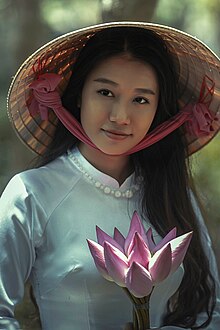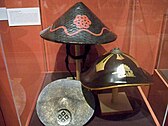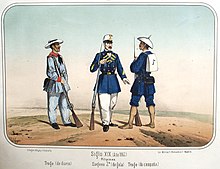
Glutinous rice is a type of rice grown mainly in Southeast and East Asia, and the northeastern regions of South Asia, which has opaque grains, very low amylose content, and is especially sticky when cooked. It is widely consumed across Asia.
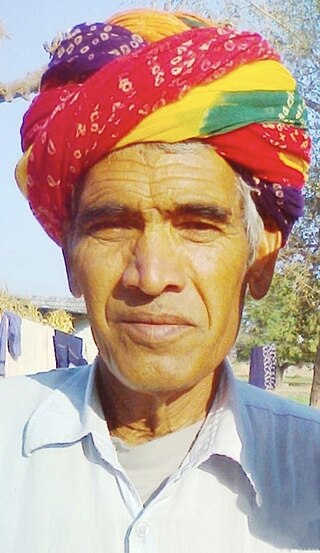
A turban is a type of headwear based on cloth winding. Featuring many variations, it is worn as customary headwear by people of various cultures. Communities with prominent turban-wearing traditions can be found in the Indian subcontinent, Southeast Asia, the Middle East, the Balkans, the Caucasus, Central Asia, North Africa, West Africa, East Africa, and amongst some Turkic peoples in Russia.

A hat is a head covering which is worn for various reasons, including protection against weather conditions, ceremonial reasons such as university graduation, religious reasons, safety, or as a fashion accessory. Hats which incorporate mechanical features, such as visors, spikes, flaps, braces or beer holders shade into the broader category of headgear.

A straw hat is a wide-brimmed hat woven out of straw or straw-like synthetic materials. Straw hats are a type of sun hat designed to shade the head and face from direct sunlight, but are also used in fashion as a decorative element or a uniform.

The Qing official headwear or Qingdai guanmao, also referred as the Official hats of the Qing dynasty or Mandarin hat in English, is a generic term which refers to the types of guanmao, a headgear, worn by the officials of the Qing dynasty in China. The Qing official headwear typically forms of part of the qizhuang system as opposed to the hanfu system and were completely different from the types of guanmao used in the previous dynasties. There were various forms of the Qing official headwear, and some were designed to be worn based on the winter or summer seasons; while others used varieties of decorations and adornment, such as the use of peacock feathers which could vary between one and three peacock eyes; these peacock feathers were bestowed by the Emperor to his officials who had accomplished meritorious services and the greatest number of peacock eyes represents the highest honour bestowed.

The pith helmet, also known as the safari helmet, salacot, sola topee, sun helmet, topee, and topi is a lightweight cloth-covered helmet made of sholapith. The pith helmet originates from the Spanish military adaptation of the native salakot headgear of the Philippines.

Pointed hats have been a distinctive item of headgear of a wide range of cultures throughout history. Although often suggesting an ancient Indo-European tradition, they were also traditionally worn by women of Lapland, the Japanese, the Mi'kmaq people of Atlantic Canada, and the Huastecs of Veracruz and Aztec. The Kabiri of New Guinea have the diba, a pointed hat glued together.

A kasa is any one of several traditional Japanese hats. These include amigasa and jingasa.

Salakót is a traditional lightweight headgear from the Philippines that is commonly used during pre-colonial era up to the present day, used for protection against the sun and rain. Every ethnolinguistic group in the archipelago has their own variant, but they are all usually dome-shaped or cone-shaped and can range in size from having very wide brims to being almost helmet-like. They are made from various materials including bamboo, rattan, nito ferns, and bottle gourd. The tip of the crown commonly has a spiked or knobbed finial made of metal or wood. It is held in place by an inner headband and a chinstrap. The salakot hat also influenced the pith helmet used by European colonizers. Salakot or also spelled as salacot in Spanish and salacco in French is the direct precursor to the pith helmet widely used by European military forces in the colonial era.

Jaapi or Japi is an Asian conical hat from Assam, India. It is made from tightly woven bamboo and/or cane and tokou paat a large, palm leaf. The word jaapi derives from jaap meaning a bundle of tokou leaves. In the past, plain jaapis were used by ordinary people in Assam and by farmers for protection from the sun, while ornate decorative jaapis were worn as a status symbol by the royalty and nobility. Decorative sorudoi jaapi are made with intricate cloth designs that are integrated into the weaving.

Headgear, headwear, or headdress is any element of clothing which is worn on one's head, including hats, helmets, turbans and many other types. Headgear is worn for many purposes, including protection against the elements, decoration, or for religious or cultural reasons, including social conventions.
Salako is a hat from Îles des Saintes. It appeared towards the end of the 19th century. It is made on Terre-de-Bas Island by some last craftsmen who still have the art and the technics of its making.

Nón Ba tầm is a traditional Vietnamese flat palm hat. It should be distinguished from other traditional Vietnamese headwear such as the conical nón lá and the coiled turban, khăn vấn.

The lomphok is a ceremonial headgear of Thailand, historically worn by royalty and nobility. It is a tall pointed hat, made of white cloth wrapped around a bamboo frame. The lomphok is believed to have been adapted from the turbans of Safavid-dynasty Persia during the Ayutthaya period, and its use is extensively documented by European writers who came into contact with Siam during the reign of King Narai. In particular, its use by Kosa Pan and the other diplomats of the embassy to the court of Louis XIV in 1686 became a sensation in French society. Today, the lomphok can be seen worn by officials in the Royal Ploughing Ceremony and royal funeral processions.

The makuṭa, variously known in several languages as makuta, mahkota, magaik, mokot, mongkut or chada, is a type of headdress used as crowns in the Southeast Asian monarchies of today's Cambodia and Thailand, and historically in Java and Bali (Indonesia), Malaysia, Sri Lanka, Laos and Myanmar. They are also used in classical court dances in Cambodia, Indonesia, Malaysia, Sri Lanka and Thailand; such as khol, khon, the various forms of lakhon, as well as wayang wong dance drama. They feature a tall pointed shape, are made of gold or a substitute, and are usually decorated with gemstones. As a symbol of kingship, they are featured in the royal regalia of both Cambodia and Thailand.

The buntal hat is a traditional straw hat from the Philippines woven from fibers extracted from the petioles of buri palm leaves. It is traditionally worn by farmers working in the fields and was a major export of the Philippines in the first half of the 20th century. It can also be paired with semi-formal barong tagalog as well as informal attire. Its main centers of production are Baliwag, Bulacan, and (historically) Sariaya and Tayabas in Quezon Province. Buntal hats produced in Baliwag are also sometimes known as balibuntal hats, and are regarded as superior in quality to other types of buntal hats.

Liangmao, also known as Hakka hat and Hakka bamboo hat, is a traditional bamboo and/or straw hat worn by the Hakka people who perform manual work, such as farming and fishing. Hakka women wore it when working in the fields. The liangmao is made and is most commonly worn by the Hakka people who were originally from Northern China. The liangmao is a typical symbol of Hakka culture and is a "unique feature of Hakka culture"; it is also the "most public symbol associated with the Hakka". Some Hakka women still wear the liangmao when working outdoors nowadays. It also worn by non-Hakka women who work outdoors.

A shepherd's hat is a head covering, used by a shepherd to ward off the sun and the elements. Along with a crook, it is an important tool for the shepherd.
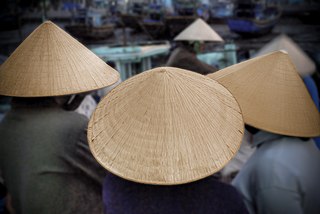
Nón lá or nón tơi is a type of Vietnamese headwear used to shield the face from the sun and rain. Nón lá is a typical symbol of the Vietnamese people. Nón lá is a common name for many types of hats in Vietnam, but now it is mainly used to refer to cones with pointed tips.

